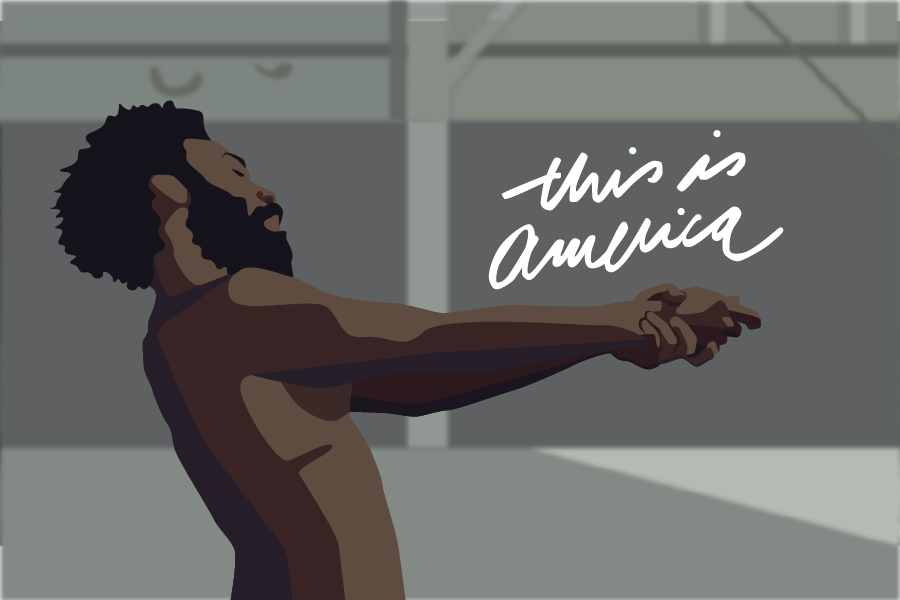
Adding to discussion about race, politics
48 seconds of light, feel-good music captivate listeners in the beginning of Childish Gambino’s new song “This is America.” However, around 47 seconds into its accompanying music video, we are introduced to the jarring image of a man sitting in a chair with a cloth bag over his head. He is shot in the head seconds later by Gambino, and a shift in the tone of the music occurs as the sound of his gunshot rings.
In the moments leading up to the killing and all throughout the rest of the music video, Gambino is shown dancing wide-eyed with his shirt off. But the dancing is strained and it is the first indication that something isn’t exactly right, even before he shoots the man. His facial expressions depict someone going through the motions and not really being comfortable with his body performing all these moves.
His demeanor changes to indicate he’s succumbing and, in turn, putting a lot of effort into the execution of these movements that are very reminiscent of popular dance moves blasted all over the internet. The exaggeration and forced quality show just how imposed the happy image of the Black experience in America is when, in actuality, it’s the complete opposite. This stark contrast between the “popular culture’s perception of black experience and its often brutal reality,” according to a contributor on Genius Lyrics, is shown in other ways, too, and is the main idea of the video. The same contributor argues that this is exemplified most clearly “by juxtaposing happy, carefree choruses and dark, aggressive verses.” This is matched in the video with chaotic, ominous scenes in the background while Gambino dances both alone and with a crew of people in the foreground.
And when Gambino isn’t dancing, he is engaging in the violence — namely, shooting people. The first instance was the one at the beginning of the video and, in retrospect, that shooting was the one most set up to happen. Compared to watching the second instance, in which Gambino reenacts the Charleston church shooting (with himself as the shooter and an ensemble of Black gospel singers as the victims), it is more shocking and unexpected every time. He follows up the silence of the gospel singers with a pronounced “This is America” with a stoic face. It is unsettling.
If you take a closer look at the cars that Gambino is surrounded by and dancing on top of, you notice none of them are expensive and are decades old. For me, it seemed to point at police brutality, given that many tragedies and/or displays of racism arise from a white cop pulling over someone of color in their car. Other than that, the persistence of income inequality (and disparities between people of color and white people in general) is also something the scene alluded to given that, again, the cars are old and inexpensive.
The final scene we are left with is Gambino sprinting towards the camera with a mob of people following him in the dark. This has been compared to the Sunken Place from Jordan Peele’s movie “Get Out.” According to a tweet Peele posted in March of 2017, “the Sunken Place means we’re marginalized. No matter how hard we scream, the system silences us.”
The Washington Post summed it up perfectly in an article on this very topic: “Whether this reference was intended, the video makes clear how black people have been trapped and/or harmed by American culture. Gambino seems to keeps the darkness at bay by acting within white-imposed boundaries for most of the video — hence the rich depth of field, with his giddy dancing layered in front of violence — but it eventually catches up with him.”
What I initially thought of as Childish Gambino’s attempt at new age trap rap was quickly transformed into a greater appreciation for his project. However, Donald Glover (the man behind the musical project Childish Gambino) isn’t really interested in the analyses taking place. At the Met Gala, in response to a Vogue representative asking him what he would like people to feel when they see “This is America,” he replied, “I honestly just wanted to make a good song. That was it. Honestly I just hope people, you know, get to just enjoy it.”
In a Jimmy Kimmel interview, Glover stated how sensitive he is and how he hasn’t been on the internet since the Thursday night before he first debuted “This is America” on Saturday Night Live for fear he will take criticism too personally.
What we have here is an artistic expression and statement by a talented musician, artist and actor. We are well within our rights to examine, discuss and praise the depth Gambino added to his productions and what they mean in a greater context. But at what point is it over-dissection?
Ultimately the story Childish Gambino weaves is extremely intimate to him, his roots and the people that can relate to it. Maybe in all the close inspections we break down this intimacy.
Written By: Cecilia Morales — arts@theaggie.org



